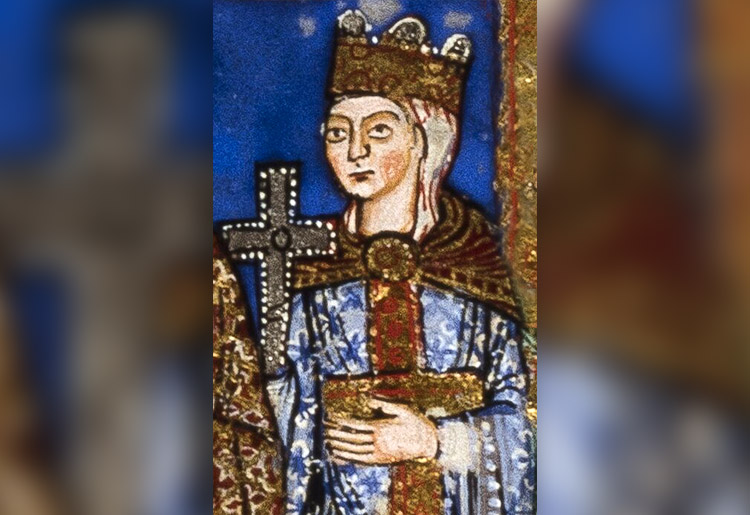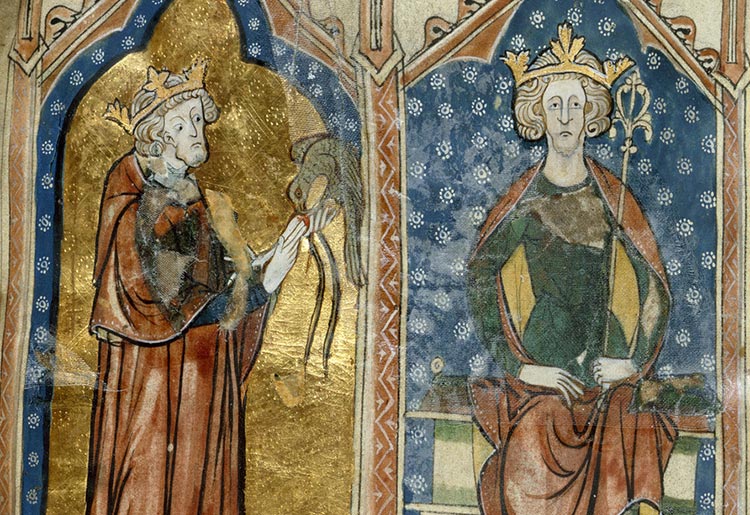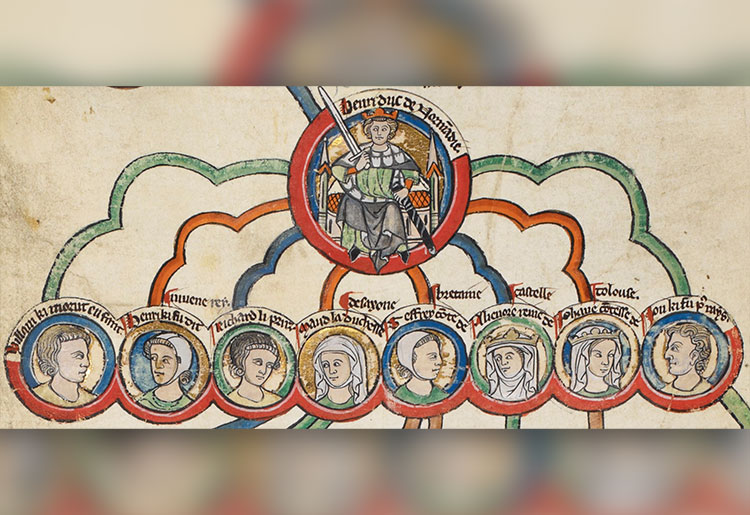
On 19 December 1154 King Henry II was crowned at Westminster Abbey. He could be regarded as one of England‘s greatest monarchs after inheriting and uniting a ruined and divided kingdom before earning a fearsome reputation as an empire builder on the continent.
The husband of the formidable Eleanor of Aquitaine and father of John and Richard the Lionheart, Henry’s action-packed reign gave rise to England’s position as a European power to be reckoned with.
Henry was a very young man when he was crowned, having been born just twenty-one years earlier in 1133. He was the son of Empress Matilda, William the Conqueror’s granddaughter, and Count Geoffrey Plantagenet of Anjou, and had a legitimate claim to the throne of England through his mother’s line.
Stephen and Matilda
In fact, when her father Henry I died in 1135 Matilda vociferously voiced her own rights to the throne, only to see her cousin Stephen seize it for himself. Though no woman had ever ruled England, she refused to give up and launched a civil war to claim her birthright.
The reign of the unfortunate Stephen was dogged by the internal fighting known as “The Anarchy” and England was economically ruined by the constant ravages of war.
Much of Matilda’s support came from the south-west, and the young Henry was given his first taste of life in England in 1142 when he was sent to be tutored in Bristol. Meanwhile, his mother fought on, and famously escaped from the besieged castle of Oxford in 1141.
Henry’s first military escapade came at the staggeringly young age of 14, when he lead a band of mercenaries to ravage England’s east coast. It would be the first step of a long and illustrious military career.

Contemporary miniature of Henry’s mother, Empress Matilda, from the ‘Gospels of Henry the Lion’
Image Credit: Public Domain, via Wikimedia Commons
Chroniclers describe Henry as red-haired, and handsome despite being short and famously scruffy. Though a highly intelligent and learned man, he was infamous for his terrible rages and even more threatening silences if things didn’t go his way.
Despite this, his charm and good humour are equally well attested, and even in his teens he had all the attributes to become an exceptional leader of men.
Henry and Louis
Geoffrey, an ambitious father, made Henry the Duke of Normandy in 1150, beginning a lifelong enmity with Louis, the King of France, a man who resented the growing power of Geoffrey’s Plantagenet dynasty. To add insult to injury, after Geoffrey died a year later the eighteen year-old Henry began an audacious marriage.
Louis’ Queen was the beautiful and intelligent Eleanor of Aquitaine, a woman whose dowry included huge swathes of land in what is now southern France. After she failed to give him any children, the French King had the marriage annulled.
Just eight weeks later, however, the teenage Henry had seduced Eleanor and married her, in a move that was both shocking in its rudeness and its aggression, for Henry was now the owner of more French land than the King of France himself. And his ambitions, spurred on by his wife and mother, were only just beginning.
 Listen Now
Listen NowComing to power and consolidation
1153 would prove to be the decisive year in Henry’s life, as he set sail through winter storms to England.
Though he could only spare a small force of mercenaries, his forces danced around King Stephen’s larger army until worsening weather caused a temporary truce. In that time Henry consolidated his hold on the north and enjoyed playing the part of King while the ageing Stephen fretted.
Luck would favour the younger man when Stephen’s eldest son Eustace suddenly died of an illness, and after the two rivals’ armies faced each other at Wallingford Castle, the exhausted King of England met with Henry and confirmed him as his heir.
Though the peace was precarious and there are theories of an attempted plot to murder Henry and put Stephen’s second son on the throne, the Plantagenet luck stayed with the young invader, for in October 1154 the King died aged 62.
Henry still had a huge amount to do, however. In England at that time much of the power rested with the Barons who had their own castles and private armies. In the lawless years of the anarchy many of them had declared de facto independence and began building new fortresses without royal permission as bases for their armies to harass rivals.
In addition, much of the country’s economy was in ruins and few expected the new and inexperienced King to adequately deal with the situation when Stephen had so conspicuously failed to do so. Henry however set about the kingship with a youthful energy which quickly healed his new kingdom.

King Stephen standing with a falcon, and King Henry II seated on his throne
Image Credit: British Library, CC0, via Wikimedia Commons
Holding court and smashing the Barons’ illegal castles with glee, Henry quickly became a popular monarch, particularly after forcing the Scottish and Welsh out of their English possessions which they had taken during the chaos of the Anarchy.
Unlike his mother, who had been often-derided for her arrogance, Henry took care to listen to the advice of the English Barons, ensuring that he had enough loyal men doing his bidding to keep the country in check.
He needed them. For Henry did not see himself as an Englishman. Less than a hundred years after the Norman Conquest, to him the English were an alien people to be ruled by their Norman-French overlords.
Though Henry was a fairly benign monarch, he believed that his destiny lay on the continent, the land of his ancestors and the scene of his endless quarrels with France.
One modern French historian has compared the situation in the 1150s with the Cold War, in that Henry and Louis were constantly meeting face to face in order to try and resolve the rowing tensions between them, whilst secretly trying to shift the balance of power in a favourable way.
Henry’s forays into semi-independent Brittany and Tolouse met with success, and in 1161 his rivalry with Louis finally exploded into fighting. After taking the city of Blois in an impressive siege, the King of England was in the ascendancy, and it took the intervention of the Pope to prevent further fighting.
Twenty years into his reign Henry would rule over England, much of Scotland, Wales and Ireland, and almost all of the west of modern France. It is not for nothing that historians have come to christen his lands the “Angevin Empire.”
Empires, however, are notoriously difficult to run, and Henry’s dealt with the problem of ruling his extensive lands in a number of ways. Firstly, like the Romans before him, he took a relaxed approach to central control and generally allowed local feudal lords to do the hard business of ruling for him.
 Listen Now
Listen NowThe House Plantagenet
Secondly, the governance of the Empire has been described as a “family affair,” with Matilda and Eleanor wielding huge influence. The later was left in charge of England on numerous occasions while the King was away, and was entrusted with much of the responsibility for her homeland of Aquitaine in the south of France.
Having such an ambitious and talented family was seen as a strength initially, particularly after Eleanor gave birth to a host of sons, but it would eventually prove to be Henry’s undoing.
The early years of the 1170s were eventful for the now middle-aged King. By 1173 he had already invaded Ireland, divided up his Empire between his sons and arranged the infamous murder of Thomas Becket, Archbishop of Canterbury. That year, however, everything fell apart, and family was at the center of it.
Henry’s eldest son of the same name had been chafing for years under his father’s rule, and when some of his castles in France were given to the King’s youngest son John his resentment burst into open rebellion.
Supported by a formidable coalition of France, Scotland, Flanders, his brothers and even his mother – whose relationship with the King had disintegrated – the younger Henry waged war on his own father for over a year.

13th-century depiction of Henry and his legitimate children: (left to right) William, Young Henry, Richard, Matilda, Geoffrey, Eleanor, Joan and John
Image Credit: Anonymus, Public domain, via Wikimedia Commons
Later years and downfall
Few Kings have ever had to face a bleaker situation with his own family against him and invasions on all sides, but Henry held off despair for long enough to defeat all the rebellions and reclaim his lordship over the Empire.
His life, however, could never be the same again. Eleanor was imprisoned, and all the King’s sons but his youngest John could never be fully trusted.
Embittered and resentful, the final years of his reign had him in a strong position but a state of acute misery and mistrust.
By the end of his life his eldest son, Richard, was once again in open rebellion. In hot French weather in 1189 the tired and ailing King met his son and acknowledged him, with some bitterness, as his heir.
Sick and perhaps tired of life, he died shortly after, to be succeeded by the man who would one day be known as the Lionheart, but who had showed little courage in his treatment of his own father.
Henry was not a perfect man. His temper, odd ways and distance as divinely ordained monarch ultimately turned his family against him, but few historians can contend that he was a fine King.
By the end of his reign, his more famous heir was able to leave a stable and prosperous Kingdom and lead the forces of England east to face Saladin and win renown across the world.














